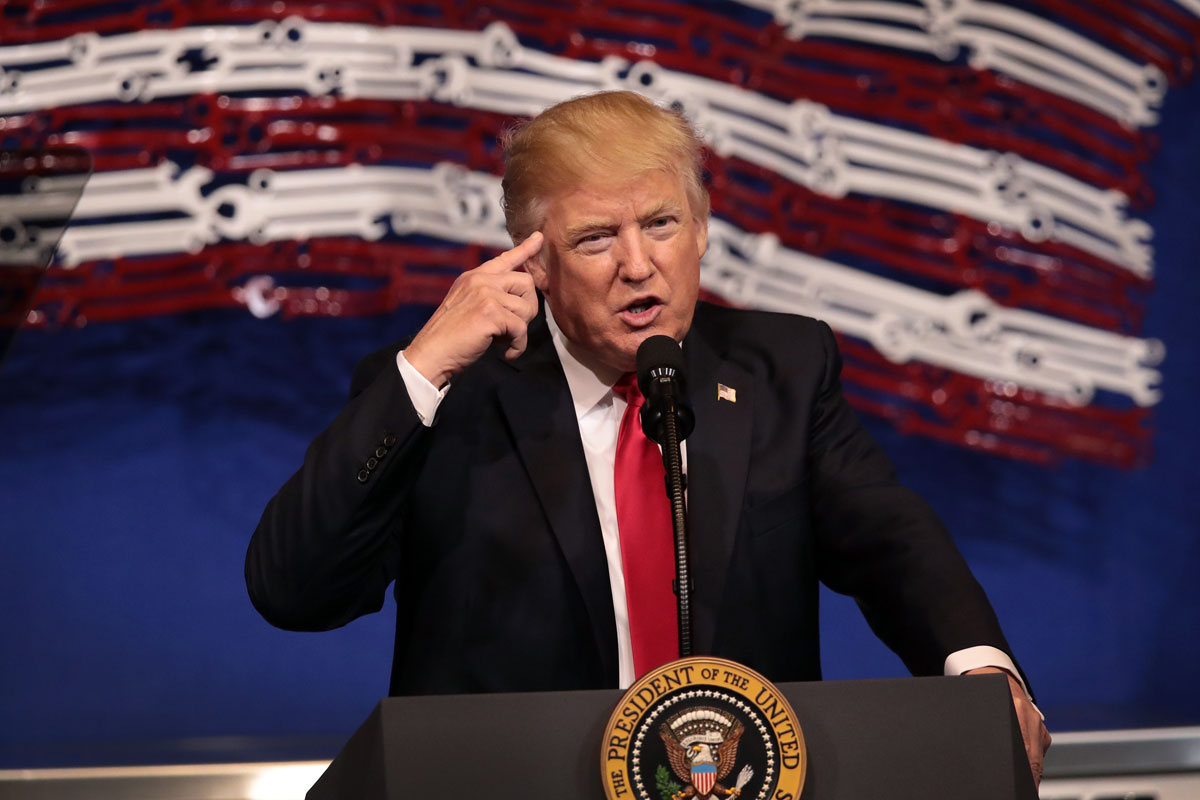Trump Orders Overhaul of H-1B Visas, Indian Techies to be Hit as Visa Applications Decline
President Donald Trump speaks to workers at the headquarters of tool manufacturer Snap-on on April 18, in Kenosha, Wisconsin. During the visit, Trump signed an executive order to try to bring jobs back to American workers and revamp the H-1B visa guest worker program. (Scott Olson/Getty Images)
@Siliconeer #Siliconeer #H1BVisa #DonaldTrump #USCongress @TiESV #TiESV #IndianAmerican #USImmigration #Tech #SiliconValley #Community – In a blow to Indian IT industry and professionals, President Donald Trump has signed an executive order for tightening the rules of the H-1B visa program to stop its “abuse” and ensure that the visas are given to the “most-skilled or highest paid” petitioners. According to USCIS figures, it received 37,000 less H-1B petitions for the fiscal year 2018 beginning October 1 this year than the 236,000 it received in 2017, writes Lalit K. Jha.
Acting on his ‘Buy American, Hire American’ pledge, Trump signed the order that calls for an overhaul of the H-1B program at the Kenosha, Wisconsin, headquarters of toolmaker Snap-on, April 18.
“Right now, widespread abuse in our immigration system is allowing American workers of all backgrounds to be replaced by workers brought in from other countries to fill the same job for, sometimes, less pay. This will stop,” Trump told an enthusiastic audience in Wisconsin before signing the order.
He said the order sets in motion the first steps to initiate “long-overdue” reforms to end “visa abuses.”
“Right now, H-1B visas are awarded in a totally random lottery, and that’s wrong. Instead, they should be given to the most skilled and highest-paid applicants, and they should never, ever be used to replace Americans,” he asserted.
“No one can compete with American workers when they’re given a fair and level playing field, which has not happened for decades,” he said.
Trump said his administration is going to enforce ‘Hire American’ rules that are designed to protect jobs and wages of workers in the United States.
“We believe jobs must be offered to American workers first. Does that make sense?” he said.
But the New York Times noted that Trump’s announcement came at a jittery time for the White House, as he faces the 100th day of his presidency without much to show for it in the way of legislative accomplishment, after the defeat of his healthcare overhaul.
“And his two high-profile executive orders cracking down on immigration from predominantly Muslim nations have been stymied by the courts,” the paper pointed out.
Trump’s executive order also declares that American projects should be made with American goods.
“No longer are we going to allow foreign countries to cheat our producers and our workers out of federal contracts.
Everyone in my administration will be expected to enforce every last ‘Buy American’ provision on behalf of the American worker, and we are going to investigate every single trade deal that undermines these provisions,” he said.
According to the executive order, the Secretary of State, the Attorney General, the Secretary of Labor, and the Secretary of Homeland Security shall suggest reforms to help ensure that H-1B visas are awarded to the most-skilled or highest-paid petition beneficiaries.
In a statement, the White House said H-1B visas are supposed to bring the highest skilled and paid labor to the United States.
But according to studies, 80 percent of the approved applications were for the two lowest wage levels allowed.
“Currently, companies routinely abuse the H-1B visa program by replacing American workers with lower paid foreign workers,” it said.
Reforming the H-1B visa system was one of the major election promises of Trump.
India accounts for the highest pool of qualified IT professionals, whose services go a long way in making American companies globally competitive.
As mandated by the Congress, the U.S. Citizenship and Immigration Services every year issues 65,000 H-1B visas and another 20,000 to those applicants having Masters and higher degrees from a U.S. educational institution.
This month USCIS received 199,000 H-1B visa petitions and as a result, the federal agency had to resort to a computerized draw of lots to decide the fate of successful applicants.
Betsy Lawrence, the director of government relations for the American Immigration Lawyers Association, told CNN that, “Although released with ceremonial flair, the order will have no immediate impact on H-1Bs.”
“Many of the changes to the H-1B program contemplated by the administration would require legislative action or rule-making and would take time to go through the necessary processes,” he said.
Meanwhile, some U.S. lawmakers said the executive order signed by Trump calling for a review of H-1B visas was too little and too late.
“This does nothing,” said Senator Charles Schumer of New York, a Democratic leader. “Like all the other executive orders, it’s just words – he’s calling for new studies. It’s not going to fix the problem. It’s not going to create a single job.”
“We already know H-1B visa abuse hurts American workers. Simply reviewing the program is too little, too late,” Senator Dick Durbin said.
U.S. lawmakers have already tabled more than half a dozen legislations in the Congress with specific proposals to reform and improve the H-1B visas systems. Many of those proposals, according to industry body NASSCOM, are discriminatory and are targeted towards Indian IT companies.
The U.S. tech industry and corporate sector, however, has welcomed the “much-needed” review of the H-1B visa program and expressed confidence that it would help them bring in the best and the brightest from across the world.
Steep Decline in H-1B Visa Applications this Year: USCIS
The United States Citizenship and Immigration Services said, April 18, that it received 199,000 H-1B applications for the 2018 fiscal year, beginning October 1 this year, which is 37,000 less than the 236,000 it received in 2017.
These applications were received in the first five days before USCIS stopped receiving the H-1B petitions.
The successful applicants have been decided on the basis of a computerized draw of lots.
USCIS, as per Congressional mandate can issue a maximum of 65,000 H-1B visas every year.
In addition, it can issue another 20,000 to those who have completed their higher education at a U.S. university.
In 2017, USCIS had received 233,000 applications. In 2015 it had received 172,500 H-1B applications and 124,000 in 2014.
The USCIS gave no reason for the drop in H-1B visas this year as compared to the previous two years, but experts attributed this to the current rhetoric against it.
This years applications are “surprisingly low,” William Stock, president of the American Immigration Lawyers Association told San Francisco Chronicle.
Stock said a reason behind the drop could be that companies that hire engineers to handle other businesses’ programming needs may have filed fewer applications.
India’s Infosys, Tata Consultancy Services and Wipro accounted for the majority of H-1B applications filed in California last year, the daily reported.
Frustration behind the lottery system could be another reason for the drop in the applications, said Martin Lawler, a Bay Area immigration attorney.
“We need more math-based professionals, and it is quite depressing that we can’t go out and get the best and brightest,” he told the daily.
He said the demand “is going to continue so long as Silicon Valley is doing well.”
Meanwhile, President Donald Trump signed an executive order, April 18, that would tighten the process of issuing the H-1B visas and seek a review of the system for creating an “entirely new structure” for awarding these visas.


